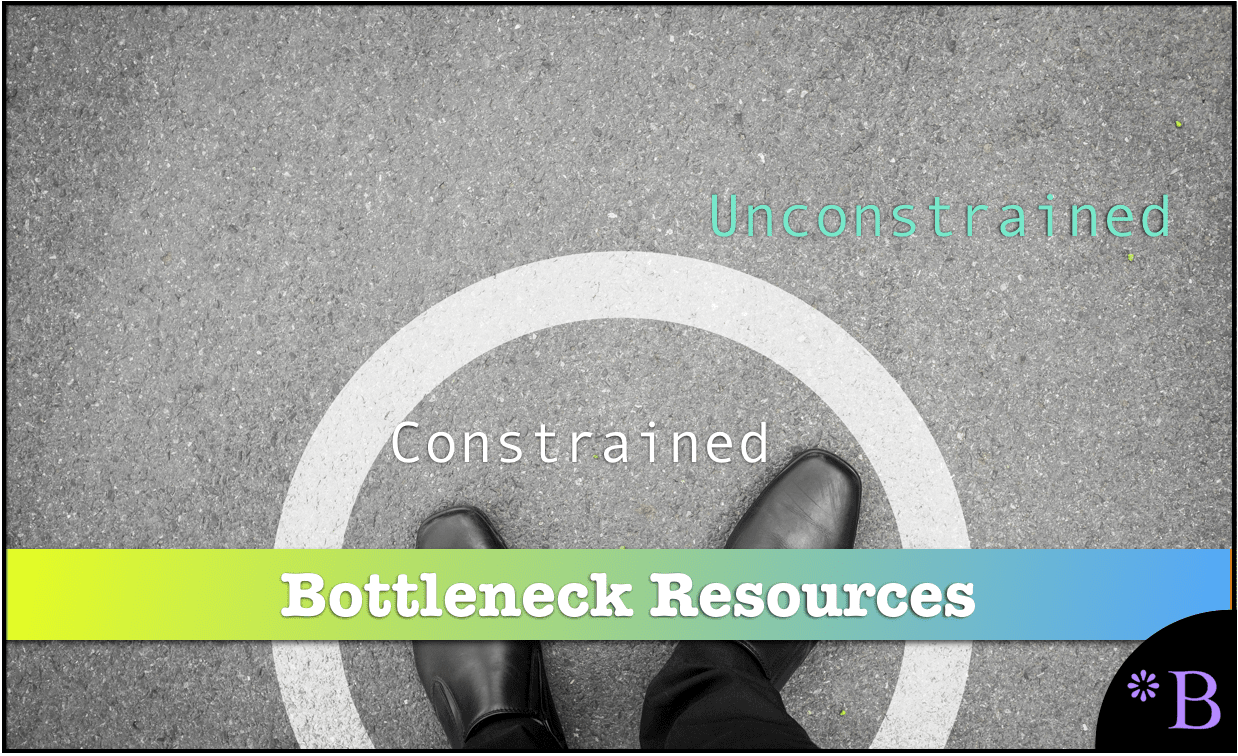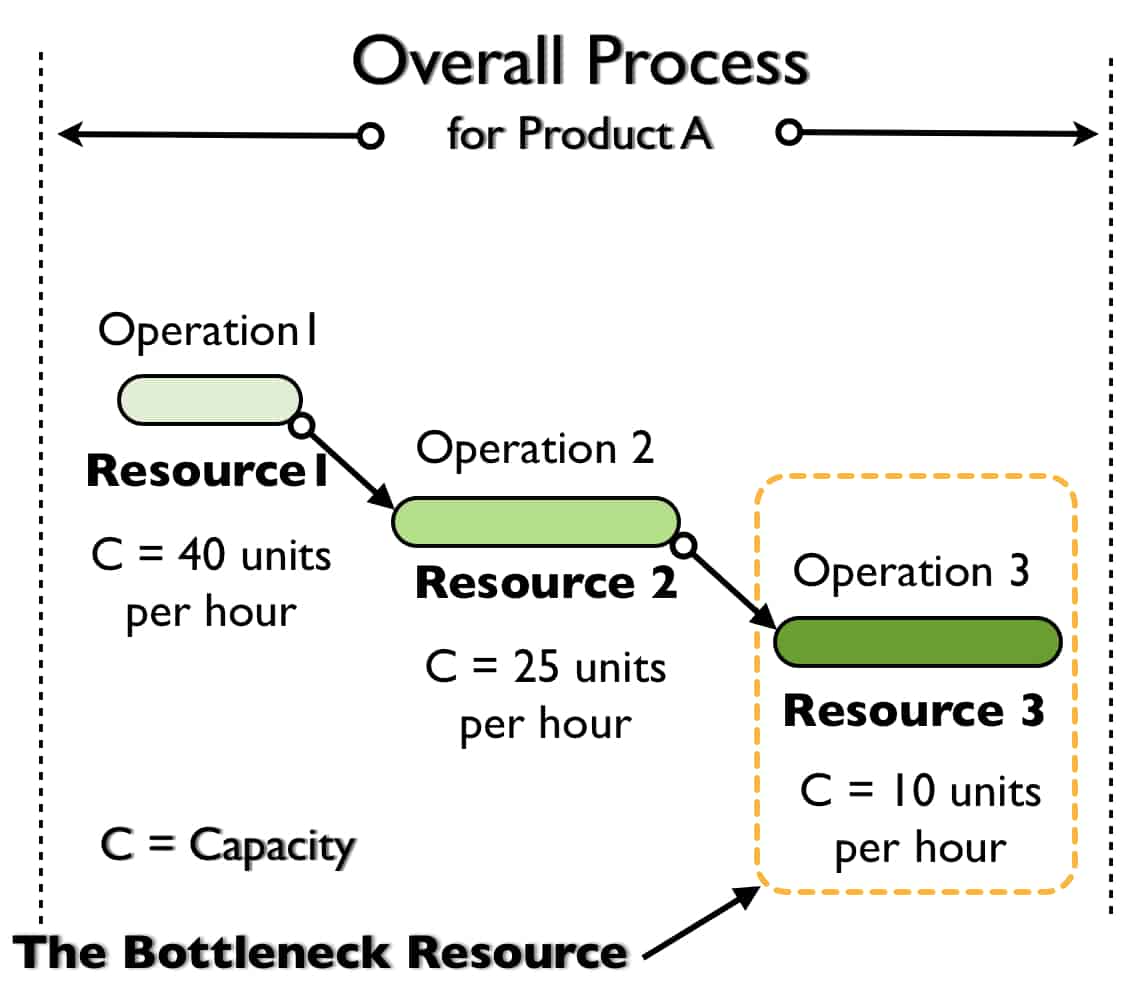How to Best Understand Manufacturing Bottlenecks
Executive Summary
- We cover the definition of a bottleneck resource, as well as the bottleneck production rate.
- The concept of bottleneck resources was based upon Eliyahu Goldratt and the book The Goal.
- Bottleneck resources don’t apply to non-sequential production lines.

Introduction to Bottlenecks
Much of the production planning and scheduling philosophy is based upon managing the bottleneck process, bottleneck resource, or bottleneck operation. In this article, you will learn the pertinent information to a bottleneck in production.
Bottleneck Definition and Bottleneck Meaning
An appropriate bottleneck definition is that a bottleneck is an area that restricts the overall capacity.
The bottleneck meaning is as in a bottleneck in a bottle of wine; the bottleneck restricts the rate of speed with which the liquid can be poured out of the bottle.
The bottleneck meaning is to take the analogy of a bottle and apply it to a system. Bottlenecks can be studied in any number of systems, but we are limiting our discussion to the bottleneck in production for this article.
A bottleneck definition should be considered in the context of the bottleneck resources in a production system.
It is quite typical for many of the resources that are assigned to a product to be unconstrained in a production planning and scheduling system. Frequently, only the most limited resource or “bottleneck resource” is constrained. The bottleneck resource is the pacesetter for the overall processing of the product. However, if no resources for a product are constrained, then the planning for that product—at least at that location—is infinite. The graphic on the next page describes how bottleneck resources work:

The bottleneck operation and resource are Operation 3. Because Resource 3 produces the lowest amount of units per hour, it restricts the capacity of the overall process, or sequence, to ten units per hour. The overall process cannot exceed the capacity of the slowest resource (unless the slowest resource runs for more hours per day than the rest of the resources). For this reason, it is unnecessary to constrain the capacity of either Resource 1 or Resource 2. This is the standard example and typically applies to a manufacturing problem.
The Bottleneck in Production or Production Bottleneck and the Production Rate
A bottleneck in production or production bottleneck is one part of the production process which restricts the capacity of the overall production line. The bottleneck resource or bottleneck operation sets the production rate or the throughput rate for the overall production line — if, and this is a big if, the operations are sequential.
Bottleneck Process, Bottleneck Resource, and Bottleneck Operation
The term bottleneck process in the manufacturing process that restricts the throughput of the production line. The bottleneck process applies to a specific resource and operation.
If there are three resources and three operations along a production line (resources A, B, and C) and (operation 1, 2, and 3), if resource B and operation 2 have the lowest throughput, then we have identified the resource bottleneck and the operation bottleneck.
During constrained production planning and scheduling, it is only necessary to constrain the bottleneck resource and operations bottleneck. So if the production rate or the throughput rate is the following:
- Resource A: 100 units per hour
- Resource B: 90 units per hour
- Resource C: 120 units per hour
Then only resource B needs to be modeled in the software. This is because the overall production line can be said to have a production rate of 90 units per hour — which is the production rate of Resource B and Operation 2.
Performing a Bottleneck Analysis
The only way that the information above could be known is if a bottleneck analysis is performed. A bottleneck analysis attempts to identify the bottleneck. However, the philosophy proposed by Eliyahu Goldratt, who wrote the popular goal book called “The Goal,” would not endorse performing the bottleneck analysis by only looking at the resource bottleneck and operations bottleneck within the production line itself. The bottleneck may be the work in process or inventory delivery system to one or all of the resources along the production line.
The Theory of Constraints, Eliyahu Goldratt and the Goal Book
The concept proposed in the goal book, by Eliyahu Goldratt, is called the theory of constraints. The theory of constraints is broadly philosophical on the topic of manufacturing. However, its central tenant is the concept of finding and eliminating the bottleneck resource.
If we take the example from earlier in this article, we can see that if we enlarge the capacity of the bottleneck resource by adding investment, Resource A now becomes the bottleneck. The increase in the throughput rate is not a little more than 10%. So the question to ask is whether it is worth it. The theory of constraints and the goal book is all about performing repeated bottleneck analysis and then repeatedly eliminating the bottleneck.
Calculating Throughput, How to Calculate Throughput Rate and Throughput Calculation
Throughput calculation is a significant part of the theory of constraints and any bottleneck analysis. Throughput calculation means determining the throughput rate for every operation along the production line. How to calculate the throughput rate is from actual observation. This is because a throughput calculation that is based on a hypothetical maximum throughput does not account for the realities of the production floor.
Non-Sequential Production Lines
Bottleneck analysis becomes much more complex when a production line is non-sequential. A good example of this is processed industry manufacturing or process manufacturing. Process manufacturing, which frequently deals with liquids, has operations that lead and lag one another. Therefore, one operation often does not begin as soon as the next one ends. Consequently, the concept of bottleneck identification is not as direct as it would be in discrete manufacturing.
Conclusion
The bottleneck in production is one of the essential concepts that are in manufacturing. The bottleneck meaning is that the resource or work center and bottleneck operation limit the overall production line’s throughput.
Bottleneck analysis was greatly popularized by the goal book by Eliyahu Goldratt, which popularized the theory of constraints. Since this time (the 1980s), bottleneck thinking is still prevalent but less popular than it once was.
Fundamentally bottleneck planning is about taking a broad perspective of the limiting factors in a production line and then adjusting those facts to find a new bottleneck.